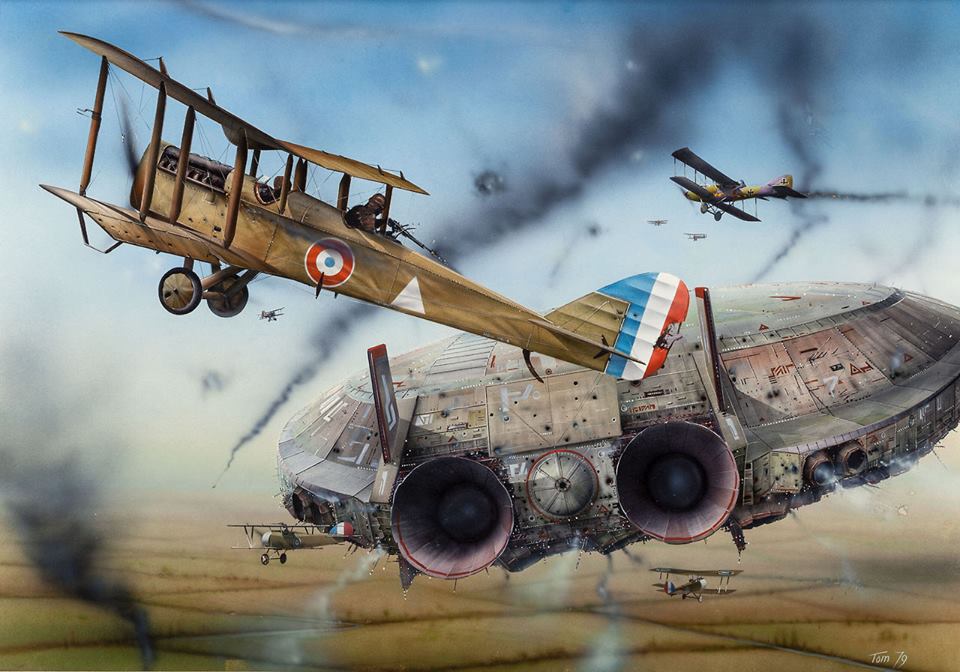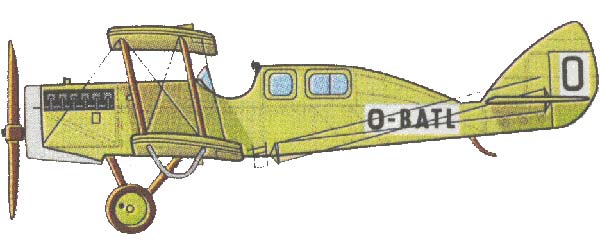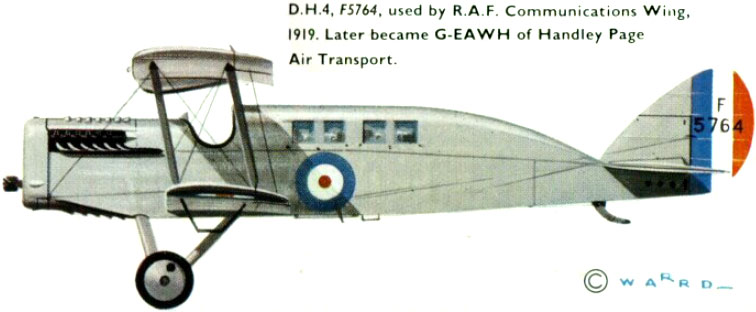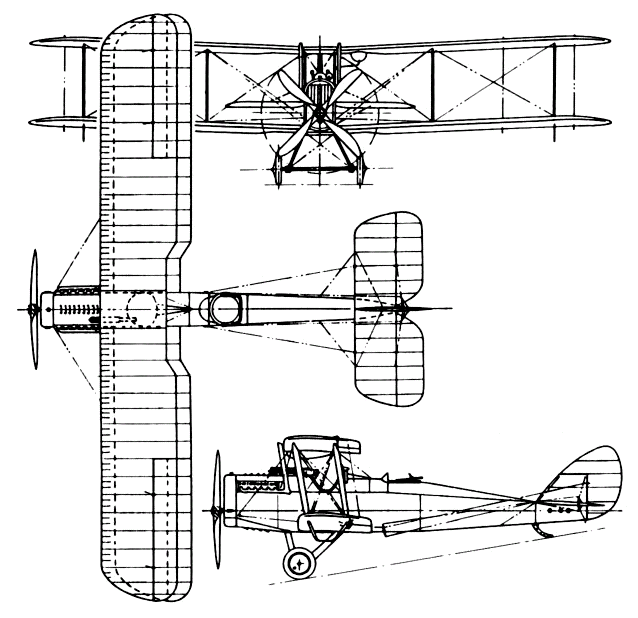 |  | ||||||||||||||||||||||||||||||||||||||||||||||||||||||||||||||||||||||||
The Airco DH.4, also known as the Liberty Plane, was a British two-seat biplane day bomber of the World War I. It was designed by Geoffrey de HAVILLAND (hence "DH") for Airco with several engines, of which the best was the 375
K-DAS resurrected this design on the whim of Major SINTAIRE, who had wanted to build a kitable biplane for some time. In fact, while aboard SDF-001 MACROSS he had built a metal model of one using scrap metal which could never fly, and was disappointed that he would be unable to recover it afterwards- The pile remains to this day in a former T'sentraedi Infantry Ammunition Locker along the port leg, just topside and aft of the hip actuator. The one surviving example of the DH-4 K-DAS researchers could find is located at the British War Museum Artifact Shelter (a converted "Anderson Shelter" that had been looted many times). It had been badly mauled by looters and the ravages of time. The plane, "Sweet Mudge," is refered to as "The Anderson Plane." Design And Development Original The DH.4 was designed by Geoffrey de Havilland as a light two-seat day bomber biplane powered by a Rolls-Royce 375 hp (280 kW) Eagle VIII or Liberty L-12 of 400 hp (300 kW) engine in a conventional tractor configuration with two bays of all-wooden construction, with the crew separated by the fuel tank. While this arrangement gave good fields of view it caused communication problems, particularly in combat. Scant little information still exists on this detail, but R&D construction involving wind tunnels and later open air flight revealed that the pilot and observer were too far away to effectively hear each other, and wind effect carried their voices away all too easily. It was armed with a single forward-firing Vickers or twin .30 in (7.62MM) Marlin Machinegun, twin 0.303 in (7.7MM) or .30 in (7.62 MM) Lewis guns on the Scarff Ring, and a bomb load of 460 lb (210 kg) fitted to external racks. Airframe The DH-4 was an all-wood frame with a canvas skin. In K-DAS's previous program, the de Havilland DH.98 Mosquito Fighter Bomber, a Mylidium hypercarbonate shell over a separate Mylidium frame was used. In this case, a uni-peice frame and shell was developed as a single casting for 5 components: Fuselage, upper left wing, lower left wing, upper right wing, and lower right wing. The rest of the aircraft's components were made as well as could be gleaned from the Anderson Plane and whatever records could be recovered to be as close to original as possible. Powerplant The original design was powered by a Rolls-Royce 375 hp (280 kW) Eagle VIII or Liberty L-12 of 400 hp (300 kW) engine. No blueprints of either engine still exists, and the Anderson Plane's Eagle VIII had been stripped for scrap metal many years earlier. Not much of anything was left but the block itself, which was too heavy to try and take (not that some didn't try, as evidenced by the rounded off mounting nuts). As such, K-DAS engineers simply started from the beginning, though with a massive electric motor connected to a hydrocell engine. Most of the "mass" of the electric motor is actually cosmetic: It makes the plane LOOK original to the outside observer. Not much could be dome about the fact that the hydrocell engines are whisper quiet compared to the original engines, although some noise could be generated by slapping metal plates of just the right size in just the right way. Most observers don't notice the difference. In fact, many complain that the planes are already too loud. Avionics Weapons Systems The armaments of the original DH-4 was armed a single forward-firing Vickers or twin .30 in (7.62MM) Marlin Machinegun, twin 0.303 in (7.7 MM) or .30 in (7.62MM) Lewis guns on the Scarff Ring, and a bomb load of 460 lb (210 kg) fitted to external racks. 5 years after production on the K-DAS DH-4 began, the blueprints for these guns turned up, but by then it was too late to do anything about. The K-DAS version "can" be armed with twin forward firing .50 Caliber M-3 Machineguns and most varieties of medium machine guns on the Scarff II Ring Mount aft. The wings can carry up to 500 lbs EACH of bombs and rockets on 4 hard points, but is not recommended. Scarff Ring: Not too much is now known about the Scarff Ring; It was a type of machine gun mount developed by a Warrant Officer SCARFF of the Admiralty for use on aircraft that incorporated bungee cord suspension, allowing an airgunner in an open cockpit to swivel and elevate his weapon in any direction. The mounting appears to have been simple and rugged, and gave its operator an excellent field of fire and was widely copied by other air forces, including the German Luftwaffe 1930's (called the Drehkranz or "Turntable" D 30) on a number of aircraft. K-DAS engineers couldn't quite replicate the Scarff Ring due to damage to the Anderson Plane (mostly running rust), so they built the best facsimile they could under the circumstances and tested that to failure. Each failure gave them a slightly better idea of what to do next, until the system was eventually perfected. The motion is smooth and fast, and the weapons train reliably on the target if the gunner is competent. Interrupter plates prevent the gunner from firing through his own aircraft, although in Block 5 planes the interrupter plates were refined to allow the gunner to fire AROUND the rudder (the rudder locks at 0 degrees when the interrupter switch is engaged, but only for 3 seconds, after which the gun is literally kicked out). Survival Systems Like it's predecessor, the K-DAS DH-4 has very little in the way of "survival systems" per se, though pilots and gunners can (and should) wear parachutes. The K-DAS does have grav pods, allowing it to control a decent, but is more of a crash-survivability system for the pilot that a true "survival" system. Personal oxygen tanks can also be carried, though is neither required nor particularly helpful at most DH-4 operational altitudes, except on VERY thin planets. The cockpit's available pilot space was increased to allow a battle armored pilot to fit (the cockpit was already fairly large, compared to the Terrans for whom it was designed, since they would be wearing u to four layers of clothes, including a very thick flight suit made of bear furs). Other than this, not much has been done. Production During WWI, production was by Airco, F.W. Berwick and Co, Glendower Aircraft Company, Palladium Autocars, Vulcan Motor and Engineering, Westland Aircraft Works of Britain, SABCA of Belgium, and Boeing Airplane Corporation, Dayton-Wright Airplane Company, the Fisher Body Corporation, and the Standard Aircraft Corporation of the United States together produced just over 11,000 units, plus spare parts, for the RFC and RNAS and USAAS. After the war a number of firms were contracted to remanufacture DH-4s to DH-4B standard (as the Model 16). Later new planes using steel tubing in place of wood frames were ordered (the "DH-4M-1" [M for modernized]). About 30 al told were converted to dual-control trainers (DH-4M-1T) and target tugs (DH-4M-1K), and 30 delivered to the Navy for Marine Corps use as the O2B-2 (equipped for night and cross-country flying). Fortunately, K-DAS doesn't generally have to worry about any of this. They produce ONE design, the current DH-4, with the best of each design based on the surviving record. For the most part, all the surviving records DID tell them was what variants were out there, not how they worked. A "night and cross country variant" doesn't say much, so a K-DAS test pilot took a stripped out airframe and flew it over open (unmarked) countryside and at night to see what the problems were. She crashed 5 times. From her experiences K-DAS engineers were able to build a profile of the design defects that cause the crashes (and developed a very healthy respect for the courage of those who flew the planes in the beginning- any one of their test pilot's crashes SHOULD have killed her). From these and other tests and types of tests, the bare minimum needs profile was developed, resulting in the installation of back lighting on all instrumentation and the GPS and basic radar. Operational History British Militry Service The DH.4 entered service with the British in January 1917, the numbers increasing for bombing capacity in May and onward. One shot down a Ƶeppelin (L70) on 05 August 1918 and 04 were credited with sinking the German U-boat UB12 on 19 August 1918. Overall it was considered the best single-engined bomber of the war and with its reliability and impressive performance was highly popular with crews, was easy to fly, and its speed and altitude performance gave it a good deal of invulnerability to German fighter interception, so that the DH.4 often did not require a fighter escort on missions, a concept furthered by de HAVILLAND in the later DH.98 Mosquito Fighter Bomber in Second World War. A drawback of the design was the distance between pilot and observer, as they were separated by the large main fuel tank. This made communication between the crew members difficult, especially in combat with enemy fighters. There was also some controversy that this placement of the fuel tank was inherently unsafe but most contemporary aircraft were already prone to catching fire in the air. When the Independent Air Force was set up in June 1918, DH-4's were used for daylight bombing by flying in wedge formations, bombing on the leader's command and with the massed defensive fire of the formation deterring attacks by enemy fighters. After the war, several DH.4s were modified with an enclosed cabin for two passengers, designated as DH.4A, with at least 16 total. United States Militry Service At the time of its entry into the war, the United States Army Air Service lacked any aircraft suitable for front line combat. It therefore procured various aircraft from the British and French, one being the DH.4, with combat operations commencing in August 1918. It became the USAAS's standard general purpose two-seater, and on the whole was fairly popular with its crews. They were used in so many ways that the numbers were lost, although the Anderson Plane's description said that one was used in an attempt to drop supplies to the 10 Companies of 77TH Division cut off by German troops during the Meuse-Argonne Offensive (the "Lost Battalion"), while another plane single handedly beat off a dozen German planes during a bombing raid late 1918. Following the end of World War I, America had a large surplus of improved DH-4B's and these were used in a variety of testing roles, including the first air-to-air refueling (25 June 1923), against rebel factions in Nicaragua in 1927 (the first dive-bombing attacks made by U.S. militry forces), and converting some DH-4M-1s into primitive air ambulances that could carry one stretcher casualty in an enclosed area behind the pilot. They DH-4 remained in militry service with until 1932. Civil Use Following the end of World War I, some were converted to passenger services in Europe, with a demonstration flight on 25 August 1919 to carry a reporter from the Evening Standard newspaper and a load of newspapers and other freight until as late as 1924. Australian airlines also used them for airmail service in 1922, and a dozen given to Canada were used for forestry patrol and survey work, spotting hundreds of forest fires up until 1927. The American Post Office adopted the DH-4 to carry air mail as a coast-to-coast service between San Francisco and New York (2,680 mi/4,310 km involving night flight) starting in 1919, being modified to be flown from the rear cockpit with a 400 lb (180 kg) watertight mail compartment replacing the forward cockpit, a revised landing gear, and an enlarged rudder until 1927, when the routes were passed to private contractors. UGC Use The Aero-Space Forces and Spacy agreed to test out the plane, but found it badly wanting in every measureable aspect. The Spacy would eventually accept some as target tugs, due to the fact that they were dirt-cheap; To fully replace one was only 20,000credit. After calculating the costs a second time, it was determined they could even be the target, with no loss. The Army and Marine felt it ‘could' be useful as a near-front infantry support plane, especially with the glazed cabin and 135 gal (511 L) fuel tank as an ambulance and emergency supply plane. One was converted to a flying bomb by loading it up with a few tons of hand grenades, pointing at an T'sentraedi stronghold on Vilnius VI, and tying the control handle in place. The pilot then simply climbed out, flew back to the ground, and rejoined her squad as a heavy machinegunner. Some Robotech Defense Forces also accepted delivery of the planes. In a move that angered many, during the Spacy and Marines's testing phase a Projects Manager from the Spaceways Patrol And Enforcement Services was invited. The gate guard did not recognize the Spacer as "not spacy" but allowed him in nevertheless; The K-DAS Programs Manager insisted the Spacer had to leave, this was for "militry" personnel only. The significant slight almost derailed the entire procurment process. Fortunately, Major SINTAIRE was on-hand that day, smoothed things over, and personally conducted the demonstrations. He didn't fire the Programs Manager, but he did keep him out of sight of those three from then on. Variants Variants are listed with the countries that used them; In the case of multiple users, they are listed in order of which country did it first, irregardless who's idea it ‘may' have been.
2 Intended purely for the civilain market, mostly as a stunt plane. Armament Original Armament
| |||||||||||||||||||||||||||||||||||||||||||||||||||||||||||||||||||||||||



